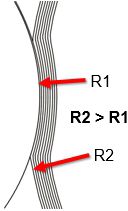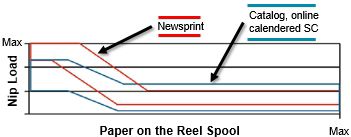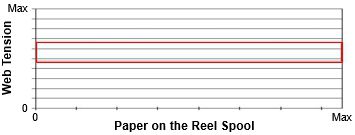Reeling parameters - tension, nip load and peripheral force
Aug 22, 2017
The reeling parameters are determined case by case according to the local conditions. The contributing factors include properties of paper or board, such as smoothness, stiffness, compressibility and friction coefficient, the parent roll size, handling method, storage time and running speed.
There are three parameters, forming the reeling recipe, to be used in the reel:
- nip load
- web tension
- peripheral force
Nip load
The nip load is the force exercising compression in the reeling nip per web width meter. The nip load is formed in the reeling nip when the parent roll is pressed against the reel drum with the primary or secondary arms.
Increased nip load makes the parent roll tighter. The goal is a low nip load value, producing a good parent roll as to its runnability.

Typically a lot of nip load is applied when reeling the inner layers and the reference value is reduced as the diameter increases. The following examples seen in Figure 2 show the nip load operation ranges typical of two paper grades.

Figure 2 Nip load range - newsprint vs. catalog paper
When using a reeling recipe, it must be taken care of that the nip load is sufficient during tail threading. When reeling certain grades, the nip load may be so low that tail threading cannot be performed.
Web tension
Web tension is the average tension of the paper per paper width meter. Web tension is created by the draw between the reel drum and the preceding drive group.
Web tension is measured with a guide roll equipped with load cells, or calculated from the reel drum drive torque.
Increased web tension makes the parent roll tighter. The most important thing is to find the correct web tension level at which the spreader roll works and the web comes to the reel in a controlled manner without edge flutter or wrinkles. Too high a web tension decreases the paper elasticity and increases the risk of a web break. Paper elasticity facilitates the runnability of further processes.
Typically, the web tension is kept constant during the entire reeling. Web tension during turn-up can be typically increased or decreased by a separate parameter. For tail threading, there is typically a separate setting for web tension.
Figure 3 shows a typical operating range of web tension values collected from newsprint machines.

Figure 3 Web tension range, newsprint
Peripheral force
Like web tension, peripheral force is a tangential force affecting the web. If reeling is done with the nip open, peripheral force is the same as web tension. When reeling is done with the nip closed, the web tension is the sum of the peripheral forces of the parent roll and the reel drum. The peripheral force tightens the parent roll structure also in the layers under the top sheet. The peripheral force can be generated by the torque of the primary and secondary drive.
When the reel spool is driven by the primary and secondary drives, a tangential force is generated in the sheets. The force calculated for the outermost sheet and divided per the paper width meter is called peripheral force. Peripheral force F = M/(r*L)
- F = peripheral force (N/m) (phi)
- M = center torque (Nm) (lb x ft)
- r = parent roll radius at the moment of observation (m) (in)
- L = width (m) (in)
As far as parent roll tightness is concerned, peripheral force is somewhere between the influence of linear load and web tension. Peripheral force enables using a larger operating range of the linear load without reeling problems. The linear load is partly replaced by the peripheral force - especially for slippery paper grades.
Typically, more peripheral force is used to create tight inner layers. When the diameter grows, the reference value is reduced. The operating range of the peripheral force that is typical for newsprint as an example is shown in Figure 4.

Figure 4 Operating range of the peripheral force curve for newsprint
Changing reeling parameters
The reeling parameters should only be changed when the paper grade changes or if there are reeling problems. It is recommended to time reeling parameter changes to coincide with the winding of the surface layers of the growing parent roll. No sudden parameter changes should be made in the middle of the reeling, because the discontinuity point generated in this way may cause a reeling defect.
For more information on building a perfect parent roll, contact your Valmet representative.